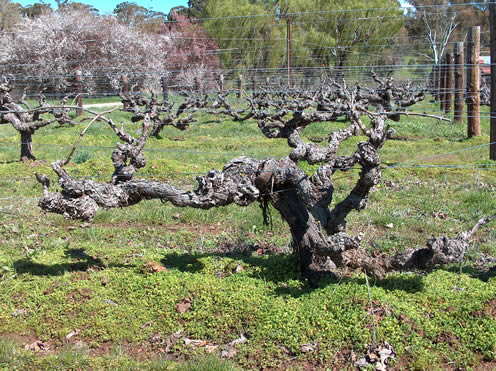Two views of parts of the Clare Valley region.
Introduction
The
distinctive combination of geology, geography, and climate of the Clare Valley,
located in South Australia, results in terroir that is ideal for producing
top-quality wines. One of
Australia’s oldest wine regions, the Clare Valley contributes only about 2% of
the Australian national grape crush; however, it wins more than 7% of all
medals awarded for wine in Australia.
The region has more than 40 wineries that lie along a narrow corridor,
most of which are small and produce bottled wines only.
Two zoomed-out maps showing the location of Clare Valley in South Australia.
History
Clare
Valley’s winemaking roots have been growing for over 150 years, making it one
of the oldest wine-producing regions in Australia. Its history reaches back almost as far as that of the nearby
Barossa region. The first grapes
were planted in the 1840’s, first by a servant and later by a group of Jesuit
Brothers who had fled religious persecution in Polish territory. They planted those first grapes at
Sevenhill Cellars, the region’s first vineyard, which is still in production
today. Sevenhill is still operated
by Jesuit monks, and much of the wine produced there is made for Catholic
religious ceremonies.
Other
pieces of the region’s history can also be seen today. Part of the valley contains an old
railway line which has been converted to what is now called the Riesling Trail,
a 17-mile bike path. Many of the
region’s restaurants and winery cellar doors are located along this trail.
A zoomed-in map of Clare Valley.
Sub-Regions
Clare
Valley contains five sub-regions:
Sevenhill, Clare, Watervale, Polish Hill River, and Auburn. The sub-regions reflect differing
interweaving creeks and valleys, so they differ in altitude, climate, and soil
type. The higher-altitude,
west-facing vineyards are thought to produce the finest wines. Also favored are the southern plains of
Auburn and the open expanses of Polish Hill River in the east.
Eldredge Vineyards.
Grapes and Wine
Clare
Valley is best known for its Riesling wines. The area is recognized now, in Australia and
internationally, as the finest region for dry wines of this variety. Almost every winery in the Clare Valley
produces Riesling. Red grapes are
grown here too, with the principal ones being Cabernet Sauvignon and
Shiraz. Additionally, Chardonnay,
Semillon, Sauvignon Blanc, Pinot Noir, Tempranillo, and Grenache are among the
many lesser varieties also grown.
The
region produces a range of varietal wine styles, conveying many different
approaches to winemaking in addition to the influences of the differing
micro-climates and sub-regions in the valleys. Grenache is used occasionally as a varietal, and is also
used as a blending constituent of red wines, as it is in many South Australian
wine regions. Recently,
Tempranillo and Sangiovese have also been introduced with positive
results. Chardonnay is also often
grown to be blended with local Semillon.
Part of a vineyard at Wendouree Cellars.
Terroir & Climate
The
Clare Valley contains substantial variation in microclimate and topography, and
is considered better for table wine production than that of fortified
styles. It produces much better
cool-climate wines than its raw climatic data and location may suggest. During the growing season, days are
warm and nights are cool. This
temperature variation, coupled with the character-forming ‘terra rossa’ soil,
makes this region favorable for producing grapes like Riesling, Cabernet
Sauvignon, and Shiraz.
Riesling’s
success in the region is directly related to the climate. The diurnal temperature variation
ensures that the grapes’ flavors and crisp acid are retained in the wine.
Also
because of the climate and temperatures, many consider Cabernet Sauvignon to be
just as successful in this region as Riesling is. This varietal’s wines can be high in body and alcohol with a
good concentration of flavors and deep color.
Though Clare
Valley’s Shiraz may be overlooked due to Riesling’s dominance, the climate
contributes to rich and tightly structured wines of this varietal, with a long
soft palate and deep color. The
region’s climate and terroir clearly leave their mark on wines.
Two images of wine labels from different Clare Valley wineries.
Left: Riesling from Grosset
Right: Viognier from Pikes
NOTE: As you can see, there are many differences in the two labels, such as the fact that one displays the sub-region of Clare Valley (Polish Hill) and the other simply says 'Clare Valley.'
Miscellaneous
There
are no government-sponsored agencies that control the production of wine from
this region. With regards to
labels, the National Label Integrity Program ensures that Australian wine is
labeled honestly. The Geographical
Indications Committee is responsible for describing, registering, and
protecting the names of Australia’s wine zones, regions, and sub-regions.
A
fun fact about the Clare Valley:
There are a few large prominent wineries, but many are considered
‘boutique,’ and have small production levels. Most of the cellar doors in the region are placed close
together, making it easy to go cellar-door-hopping.
Quelltaler Wines vineyard.
SOURCES
Google Images










No comments:
Post a Comment